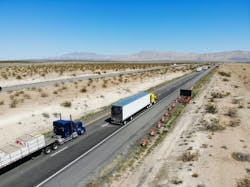In the northwest corner of Arizona, I-15 winds through a gorge alongside the Virgin River for a scenic drive. As travelers continue two miles past this gorge, they’re met with northbound and southbound bridges that carry the highway over the river.
When a $73 million construction project on these bridges was approved in 2021, the Arizona Department of Transportation (ADOT) knew it wanted to specify a Smart Work Zone to ensure the safety of the motoring public and roadway workers.
Several months into the massive project, and the 18-mile Smart Work Zone is successfully providing continuous traffic information to drivers and contractors.
A Connected Work Zone
Launched in September of 2021, the design-build construction project involves the demolition and reconstruction of both free-standing bridges over the Virgin River. Contractors are working on demolishing and rebuilding the northbound bridge first, with the entire project slated to finish in the fall of 2023.
This Smart Work Zone project is a true collaborative effort between ADOT, general contractor Kiewit Corporation, traffic control subcontractor RoadSafe Traffic Systems Inc. and transportation safety product manufacturer Hill & Smith Inc. RoadSafe manages the traffic control and lane closures using Hill & Smith equipment, while Kiewit manages construction efforts.
“Every day there are emails going back and forth between all of us,” said Jake Rieple, Rocky Mountain Regional Sales Manager at Hill & Smith Inc. “We all work together.”
Adam Carreon, ADOT Operations & Safety Engineer, Special Projects, said the department has a long history of successfully collaborating with its partners. He said he’s been impressed with Hill & Smith’s ability to deliver a high quality Smart Work Zone with a user-friendly interface that meets ADOT’s complex specifications.
Michael Thompson of RoadSafe Traffic Systems – Las Vegas, said they started installing the Smart Work Zone weeks ahead of time to test network connectivity and communication. The equipment began officially collecting data for the project in early September when lane closures began.
This is the first project in which Hill & Smith Inc. is using WZDx (Work Zone Data Exchange) to get data to ADOT. WZDx is the standardization of how data is received and shared with DOTs and is at the forefront of enhancing work zone knowledge.
What’s in a Smart Work Zone?
The Smart Work Zone on this project consists of 6 SMC Message Boards, 6 Connected Camera Trailers, and 11 Queue Detection Trailers from Hill & Smith. Each of these components works in concert to safely route drivers through the work zone and provide live traffic data to stakeholders and traffic control workers.
The Queue Detection Trailer is a portable trailer with a sensor on top that picks up real-time data including speed, volume, occupancy and classification for vehicles on the stretch of road. On this I-15 project, trailers are spaced out in 1.5 mile increments.
Rieple explains that the sensors tell the message boards what to display based on pre-programmed benchmarks and current traffic conditions. Messages include “Stopped Traffic 2 Miles”, “Slow Traffic 4 Miles” or no message at all if there is free-flowing traffic.
“The specification tells us, if traffic is at this speed, we want this message relayed on this message board,” Rieple said.
The Connected Camera Trailers offer live-stream video to help agencies keep an eye on their projects. Using solar-powered batteries, these cameras have a small footprint. Thompson said these can help workers confirm what sensors are signaling.
“Once you detect there's a drop in speed, then you can go on the cameras and just verify that visually,” he said.
Hill & Smith’s probe data partner, INRIX, is also being utilized as additional data within each corridor of the project. This provides supplementary speed data to fill in the gaps between sensor placements and extends the coverage zone by approximately 6 miles in each direction.
A Unique Job Site
While Rieple said there have been no major obstacles with the Smart Work Zone itself, the terrain and weather brought its own challenges. Along with 120 degree heat during equipment set-up, Thompson noted that extra efforts were needed to properly protect the local environment and wildlife.
“We all had to go through training on animals and plants that are indigenous to the area,” Thompson said.
These training sessions helped workers learn how to work near desert tortoises, Virgin River chubs and California condors, among others.
A Safer Future
Given the continued alarming rise in traffic fatalities in recent years, Smart Work Zones are more important than ever to ensure roadway workers and the motoring public stay safe in construction zones.
Thompson said in desert landscapes like the Virgin River area, Smart Work Zones are especially important given drivers’ propensity to speed.
“When you’re driving out in the desert, it can be desolate. So people’s perception if they don’t see any hazards, cars, hills or curves or trees—they start to get a heavy foot,” he said.
Rieple said he sees these connected work zones as the solution of the future. He has noticed more and more states implementing them more regularly to prevent collisions.
Carreon said he is certain that Smart Work Zones will become the accepted norm across the country as more DOT’s establish criteria. Smart Work Zones also offer the benefit of providing autonomous vehicles with more data to succeed.
With high quality Smart Work Zone equipment, the final result is ultimately a safer, more informed environment for workers and drivers.
“For me, the ‘future’ is now,” Carreon said. “We will continue to specify and grow the use of SWZ technology in Arizona. I look forward to the day that a SWZ is a standard work zone.”
